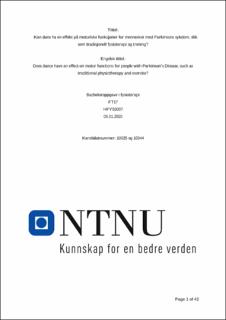| dc.contributor.advisor | Tøndel, Monica | |
| dc.contributor.author | Edvardsen, Iselin | |
| dc.contributor.author | Håvoll, Ellen | |
| dc.date.accessioned | 2020-06-04T16:01:53Z | |
| dc.date.available | 2020-06-04T16:01:53Z | |
| dc.date.issued | 2020 | |
| dc.identifier.uri | https://hdl.handle.net/11250/2656679 | |
| dc.description.abstract | Tittel: Kan dans ha en effekt på motoriske funksjoner for mennesker med Parkinsons sykdom, slik som tradisjonell fysioterapi og trening?
Hensikt: Gi et innblikk i eksisterende litteratur over hvilken effekt dans som behandlingsform kan ha på balanse, funksjonell mobilitet, freezing-episoder og nåværende motoriske funksjonsnedsettelser for mennesker med Parkinsons sykdom, sammenlignet med tradisjonell fysioterapi og trening. Vekke oppmerksomhet rundt dette temaet, og spre informasjon, og på den måten bedre tilbudet og behandlingen for parkinsonpasienter. Økt innsikt kan føre til at fysioterapeuter blir kjent med flere behandlingsformer, slik at parkinsonpasienter får et større spekter av behandlingsmuligheter å velge mellom.
Metode: Systematisk litteraturstudie. De ble utført litteratursøk i databasene: PubMed, Medline, Embase, SportDiscus, PEDro, Amed, Web of Science og Scopus i uke 43-46 i 2019. Resultatene fra BBS, TUG, UPDRS-3/MDS-UPDRS-3 og FOG-Q ble trukket ut fra studiene og tolket.
Resultat: Totalt 6 studier ble inkludert. En ikke-randomisert pilotstudie, en ikke-randomisert eksplorerende studie, en pilot-RCT, en feasibility-RCT, en quazi-RCT og en preliminary-RCT. De inkluderte studiene fant at dans trolig kan ha en større effekt enn andre fysioterapitiltak for parkinsonpasienter på testene TUG, BBS, UPDRS-3 og FOG-Q. Ut i fra dette kan det tenkes at dansing, i større grad enn tradisjonell fysioterapi og trening, kan forbedre motoriske funksjoner, balanse og freezing episoder hos mennesker med Parkinsons sykdom. | |
| dc.description.abstract | Title: Does dance have an effect on motor functions for people with Parkinson's Disease, such as traditional physiotherapy and exercise?
Aim: To give an insight in the existing literature about what effects dance as a treatment can have on balance, freezing episodes and current motor functions impairment for patients with Parkinson's disease, compared to traditional physiotherapy and other exercise. To raise awareness of this topic and spread information, and in this way improve the treatment options for patients with Parkinson's disease. Increased insight can lead to physiotherapists becoming familiar with several forms of treatment, giving patients with Parkinson's disease a wider range of treatment options to choose from.
Methods: Review. Computerized searches were conducted in the databases: PubMed, Medline, Embase, SportDiscus, PEDro, Amed, Web of Science and Scopus in weeks 43-46 2019. The results from the tests BBS, TUG, UPDRS-3/MDS-UPDRS-3 and FOG-Q were extracted from the studies and interpreted.
Results: A total of 6 studies was included. One, not-randomized controlled trial, one exploratory study, one pilot-RTC, one feasibility-RCT, one quasi-RCT and one preliminary-RCT. The included studies found that dance may have a greater effect than other physiotherapy for patients with Parkinson's Disease, for the tests TUG, BBS, UPDRS-3 and FOG-Q. Dancing seems to have a greater impact than traditional physiotherapy and exercise on improving motor functions, balance and freezing episodes for patients with Parkinson's Disease. | |
| dc.language | nob | |
| dc.publisher | NTNU | |
| dc.title | Kan dans ha en effekt på motoriske funksjoner for mennesker med Parkinsons sykdom, slik som tradisjonell fysioterapi og trening? | |
| dc.type | Bachelor thesis | |
